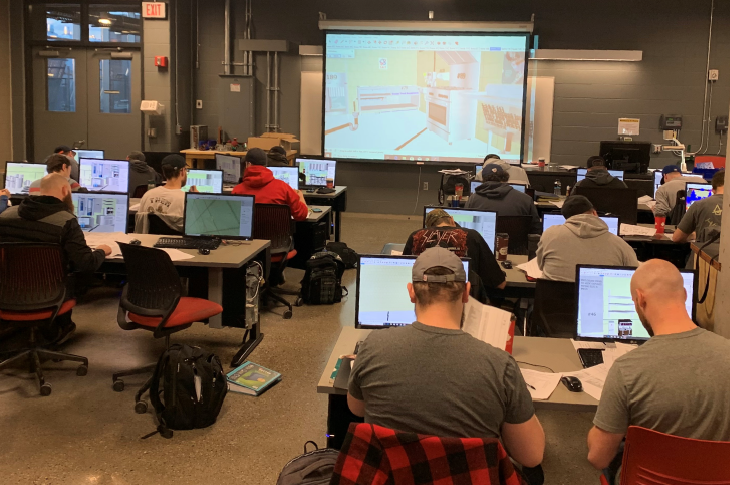Constructing the future
SAIT Instructor Fred Bretzke shares his plans for a 3D modeling lab for the trades.
Nearly every sector in Calgary has felt the effects of COVID-19, and the construction industry is no exception. Companies are enforcing physical distancing, investing in personal protective equipment and taking the time needed to safely complete jobs.
But those working in the virtual side of construction are adapting seamlessly to the “new normal.” Building information modeling (BIM) — which involves creating 3D models of buildings — and virtual design construction (VDC) are two areas proving particularly resilient during a time of more digital and remote work.
The virtual side of construction
SAIT alumnus Tom Moroney (Architectural Technologies, ’19) is a VDC coordinator at EllisDon Construction whose role involves using 3D models to coordinate and execute construction projects. The tech-heavy nature of his work — and his SAIT education — have helped him ride out the pandemic in one of the few architecture, engineering and construction roles in even greater demand.
“I work in a highly visual medium and service many far-flung project teams simultaneously, acting as a hybrid of project management and technical support,” says Moroney. “The technical and administrative skills I learned at SAIT have helped me grow accustomed to working remotely and communicating more effectively using technology during this time.”
Moroney notes that digital innovation is on the rise in construction. Following the lead of Mexico, the United States, India and most of western Europe, Canada’s industry is beginning to embrace virtual reality (VR), augmented reality (AR), and cloud-based coordination and communication.
"The architecture, engineering, and construction (AEC) industry in Canada is behind other countries in this digital transformation journey," says Reva Bond Ramsden, Dean, School of Construction. "This fact motivates us at the School of Construction to continue to evolve our education programming to close that gap.
"The technologies that are catching on the quickest are ones that address the age-old challenges that the industry continues to face: how to be more collaborative, how to be safer and how to be more productive."
Instructors at SAIT believe that to better prepare tomorrow’s trades workers, this technology should be reflected in the classroom — and they’re taking the steps to make it happen.
"Technology that focuses on increasing effective communication through better collaboration like BIM software or mobile applications that share information or connect people without having to travel became mainstream in our classrooms overnight, a silver lining to all the adjustments SAIT has implemented in response to living with COVID," says Ramsden.
A better way of teaching the trades
Pipetrades instructor Fred Bretzke and his colleagues believe the future of teaching construction is digital.
Traditional construction labs give students hands-on experience as they construct a 10-foot by 10-foot segment of a house using real materials, but limited space means it’s harder to see the bigger picture. Incorporating 3D modeling and AR software into the learning experience enables students to produce to-scale miniature and virtual models of residential and commercial properties before they do the real thing.
“This kind of technology builds more comprehensive understanding for the student,” says Bretzke, who in addition to teaching at SAIT works in the industry.

With 3D modeling, classes can see how the plumbing for a whole house comes together using G.I. Joe-sized fittings made from the correct materials. Creating an AR holographic overlay using special glasses brings the model to life in an interactive way.
“Using AR, students can create a building and then virtually step inside and walk through it,” says Bretzke.
The biggest advantage of a more digital classroom? The same technology is being used in industry, on real jobsites. Before the pandemic, Bretzke led students through the new Calgary Cancer Centre currently under construction where they discovered nine 3D animators on site. Construction projects also use AR overlays as a way of checking for accuracy and sharing data between trades.
“I’m already incorporating this technology into my teaching and students love it,” says Bretzke. “They want to see more of it.”
Bretzke plans to continue familiarizing students with 3D and AR capabilities through both in-class and online learning opportunities.
He also has plans to create a 3D modeling lab for all trades at SAIT in the next year or so. The lab would incorporate computers equipped with 3D modeling software, 3D printers, AR glasses and plenty of workspace for building models.
Break ground on your career
See how School of Construction programs position grads for career success by providing relevant, skills-oriented, and applicable learning experiences.
Skills for the Future
We prepare students for successful careers and lives.
SAIT'S
2020-2025
Strategic plan